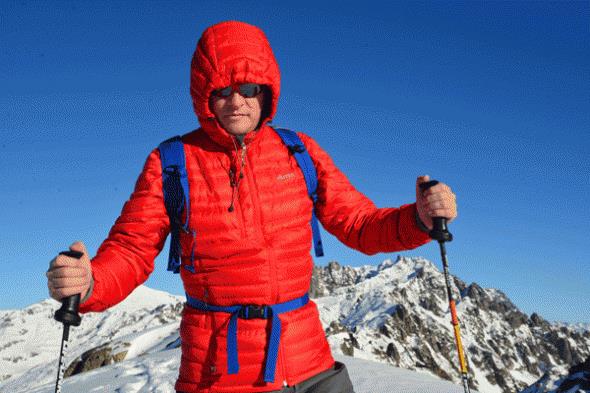We recently reviewed the Salewa Fusion Hybrid -8 sleeping bag, which was the first product we’d seen that used Primaloft’s innovative Down Blend insulation, and this month we take a look at another product – this time the Sherpa Nangpala Hooded Jacket – that uses the same technology.
Before we look at the jacket itself, a few stats about Primaloft Down Blend: Primaloft GOLD 750 uses a combination of water-repellent goose down (70%) with superfine, hydrophobic PrimaLoft fibres (30%) ; it absorbes water 10 times slower than down; it keeps 95% of its warmth if it does get wet; and it dries four times faster than down. That makes for pretty impressive reading and, as Sherpa say, it should make the jacket more useful for a wider range of conditions than a 100% down garment. But the filling is only one part of the equation, so let’s look at the garment itself.
FEATURES
According to the Sherpa website, the Nangpala comes in three colours – black, blue and green – however our test model came in a retina-searing red, which certainly stood out in the snow! The Nangpala looks like a regular lightweight down jacket, with narrow baffles running horizontally, and a micro-grid ripstop shell that Sherpa say is both water-resistant and down proof. The hood is insulated too, and large enough to accommodate a helmet; unlike some similar jackets, it has adjustors to tighten it around the face. There are two handwarmer pockets and one chest pocket, and the cuffs and hem are kept draughtproof by elastic and cinch cords respectively.
IN USE
I used the Nangpala both in cold, dry weather and also in damper conditions to further test the jacket’s Primaloft filling. I also submerged the jacket in water for 10 minutes to see how quickly it dried out. The fit of the jacket is different to most jackets of this type, with the hem coming down over the bum rather than just the hips. I didn’t mind this as it provided more warmth and meant it didn’t ride up above pack or harness straps. The jacket has a real quality feel about it, and I really liked the soft linings in the pockets and at the chin. I found the hood warm and a good size, and while the adjustors worked well the pull cords seemed to be unnecessarily long to me. As well as the two handwarmer pockets, the Nangpala has one chest pocket and two internal pockets. The chest pocket is located on the right-hand side which seems a bit strange; surely if most people are right-handed, locating it on the left side would have made more sense? While the two inner pockets were welcome, perhaps making them stretchy would have been preferable, for example, for carrying drinks bottles.
In terms of warmth, the Nangpala performed well compared to ‘normal’ down jackets, and this was no doubt helped by the hood and cinching options, which meant that little warmth was lost at the hem, cuffs and collar. The jacket is treated with a DWR but I found that it wetted out quite easily, so it may be that the coating used was not working as effectively as it should have done. In use, however, the properties of the Down Blend shone through. Even when sodden the jacket didn’t feel like it was losing much of its warmth, and after soaking the jacket it took around 24 hours to fully dry out, which was similar to the Salewa bag we tested. The bottom line is that I would take this jacket out in a wider range of conditions that a 100% down jacket – even one that uses hydrophobic down – and therefore I feel the relatively high price of the Nangpala, compared to other micro down jackets, can be justified.






